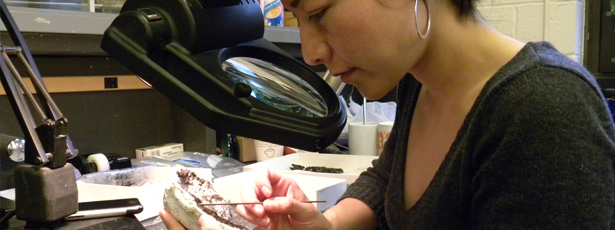Professional Development
A few aspects of fossil preparation have remained the same since the early 20th century but in general the profession is continually changing and developing. While there are ongoing initiatives to develop standards of best practices and promote accepted curricula for training within the field, it is also important for individual preparators to develop their skills and knowledge to ensure that they continue to meet high standards for their work.
There is a small but growing body of literature for vertebrate paleontological preparation but valuable information can also be obtained and adapted from other fields. The conservation of art and anthropological collections, for example, provides a wide range of papers on treatments, adhesives, storage supports, and general practices.
Preparators are the frontline in the preservation of specimens, and as such they must be aware of materials science as it relates to the longevity and stability of storage materials, adhesives, and other materials used in preparation. In effect, the preparator needs to be thinking several decades ahead, to ensure that the materials they are using will still be stable in a museum environment.
References
Use the downloadable bibliography for references on a wide range of preparation topics. Additionally, the following websites offer searchable databases of abstracts of literature; the articles themselves can often be found online or in a local library:
- AATA Online, a major database of conservation literature abstracts offered free by the Getty Conservation Institute, in association with the International Institute for the Conservation of Historic and Artistic Works.
- BCIN, the Bibliographic Database of the Conservation Information Network, is the Web's most complete bibliographic resource for the conservation, preservation and restoration of cultural property.
- The Journal of the American Institute for Conservation, is a major source for conservation literature
- Information on materials can be obtained from CAMEO a searchable information center developed by the Museum of Fine Arts, Boston. The MATERIALS database contains chemical, physical, visual, and analytical information on over 10,000 historic and contemporary materials used in the production and conservation of artistic, architectural, archaeological, and anthropological materials.
For more on this topic look at the following:
- The abstract of Matthew Brown’s 2008 paper Evaluation and certification of fossil preparators: ideas for the future given at the Fossil Preparation and Collections Symposium (FPCS) held at Petrified Forest National Park.
- The proceedings of FPCS conference mentioned above were edited by Matthew A. Brown, John F. Kane, and William G. Parker have been published. Download a copy here and read more on the development of the field in Greg Brown’s Foreword.
- Read “Preliminary Report on Professional Development in Vertebrate Fossil Preparation” Matthew Brown. 2009 Proceedings of the 15th Annual Tate Conference, Fossil Preparation and Collections Symposium June 5-7, Tate Geological Museum, Casper College, Casper, Wyoming.
Professional Organizations
Joining relevant professional organizations will help keep you up to date with advances in the field and establish contacts with colleagues. You should also attend any available workshop on preparation techniques, adhesives, or storage. These are sometimes offered in conjunction with the annual Society of Vertebrate Paleontology meeting.
- The Fossil Preparation and Collections Symposium is a workshop, which offers hands-on technical practice, as well as field trips, papers, and discussions of current thought and theory in preparation. Look for information online or on Facebook.
- The Preparators Committee of the Society for Vertebrate Paleontology maintains a website with papers, and abstracts of presentations given at the annual SVP meeting.
- Subscribe to the PrepList. This is the Vertebrate Paleontology Preparators’ E-mail list, which is open for anyone who is interested in technical insights. The list is devoted to the exchange of information, questions, opinions, etc. about preparation of vertebrate fossils. This is a very good avenue for gaining information and opinions about particular problems in preparation. No subject, related to preparation is off-limits. The list is made available by Bill Amaral, through Harvard University.
- The Journal of Paleontological Techniques is a valuable source of information on new techniques and methodologies in fossil preparation.
- The Geological Curators Group is a UK-based organization that aims to improve the state and status of geological collections and their curation. Their journal, The Geological Curator is fully archived and available on-line: it is a mine of useful information on the preparation and conservation of fossils.
- Fossil preparators are using social networking tools to advance collaborate and organize. Look for the group Vertebrate Paleontology Preparation and Conservation, and the Fossil Preparation and Collections Symposium on Facebook.
- Various organizations, including SVP, the American Institute of Conservation, and the Society for the Preservation of Natural History Collections, offer workshops on preparation techniques, adhesives, or storage, often as part of their annual meetings.
- The website of the Symposium of Palaeontological Preparation and Conservation provides information on fossil preparation in the U.K.


